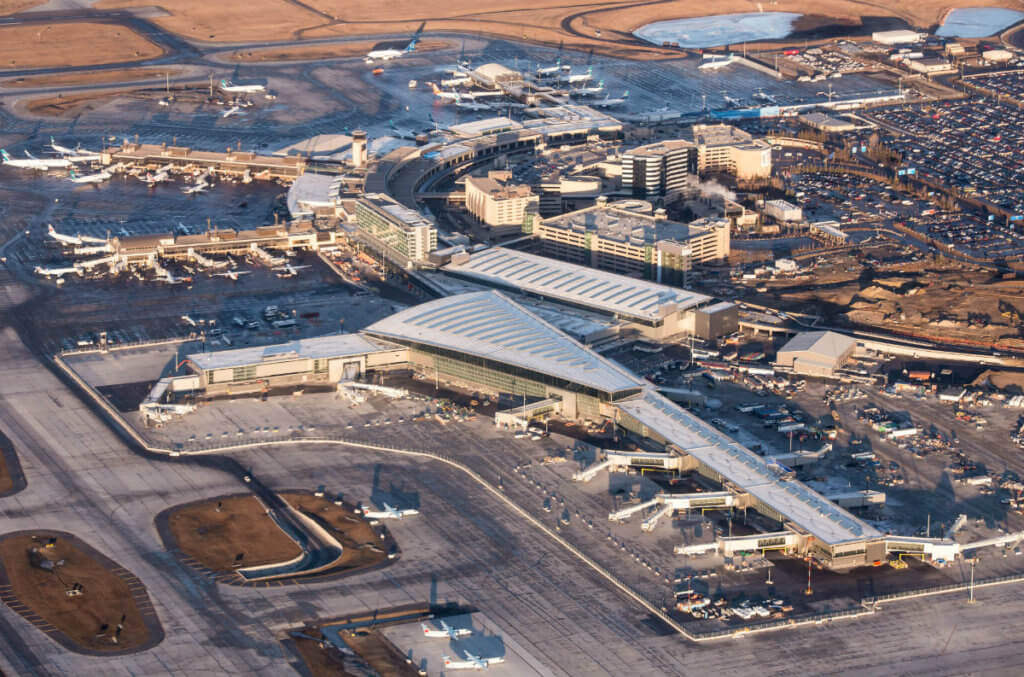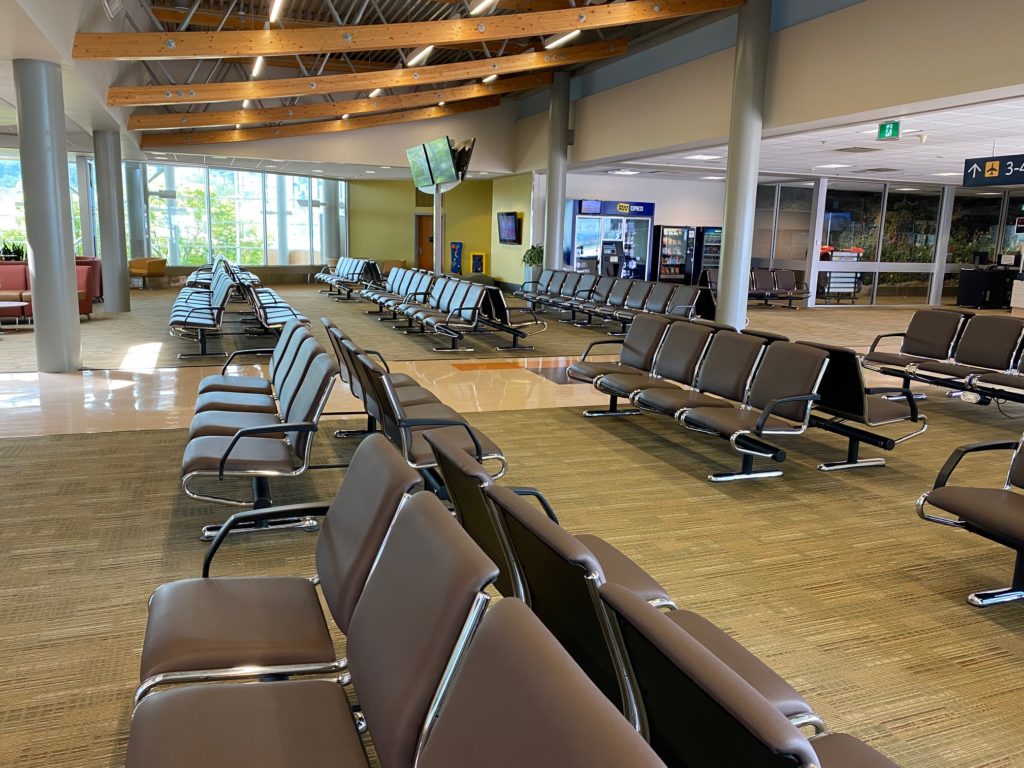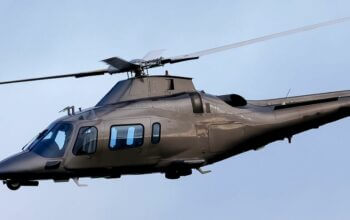Estimated reading time 11 minutes, 50 seconds.
In 2016, Calgary International Airport (YYC) opened a brand new, two-million-square-foot terminal designed to accommodate its growing U.S. and international flight operations. The cutting-edge facility features many “firsts” for Canadian airports, including 24 gates that helped YYC serve 18 million passengers in 2019.

Thanks to COVID-19, that new airport addition has gone dark. The lights are off, HVAC systems are powered down and gates are empty. Calgary airport has retracted into itself, with just one concourse out of five remaining in operation.
“We are now down to where we were in 1996,” said Bob Sartor, president and CEO at YYC Calgary Airport Authority. “We had just started growing our international business and it has completely disappeared now. We have 2.4 million square feet of airport and don’t need most of it right now, thanks to COVID-19.”
He told Skies that while January and February traffic numbers were slightly ahead of last year’s, the bottom fell out in mid-March.
“We had to take drastic action to preserve cash flow,” Sartor continued. “As passenger traffic dried up, retail businesses at the airport shut down. We laid off a third of our staff, and effectively cancelled our capital plan except for safety and security imperatives.”
YYC’s senior leadership team of six people began meeting five days a week to develop and execute the airport’s pandemic response plan. It was a scenario that played out across the country as borders were closed and flights cancelled.
But now that it has successfully leaned out its operations, Sartor said YYC is planning for the eventual economic recovery and what will be required to bring the airport back online.
“It’s definitely not going to be business as usual, no,” he said ruefully. “Like most airports, we are massively overbuilt right now and we will need to grow into that complex, step by step.”
In emergencies like this, Sartor explained that airports try to preserve cash flow while accessing standby lines of credit to keep the operation moving. Since YYC predicts it will run a loss for the rest of this year and a good chunk of 2021, access to secondary financing is going to be critical to ensuring survival.
That’s where the federal government could really help airports, he said, by providing loan guarantees that would reduce the potential for an airport to be declared in default on its primary credit line. Essentially, this would help airports to borrow more money even while they are running large losses.
In March, Ottawa announced it would waive ground lease rents from March 2020 through December 2020 for 21 airport authorities across the country, plus Billy Bishop Toronto City Airport which is operated by PortsToronto.

However, while Sartor said the move is certainly appreciated, “the reality is our rents are driven by our revenues and our revenues are nearly non-existent. By virtue of how poor our business is at this time, we wouldn’t have had to pay much anyway.”
But when air travel begins to make a comeback, he said a government offer to provide rent relief for “an extended period of time” would allow airports to direct those rent dollars toward paying off debt.
“Needless to say, most airports today have hunkered down, doing the necessary things. But it’s a question of conserving as much cash as we can.”
Many in the aviation industry have stated they believe a full recovery will take years, not months, and the timing is largely dependent on when a COVID-19 vaccine can be developed and deployed.
“It’s a multiplicity of factors that will depress air travel,” Sartor asserted. “One of them is that there is fear out there. People are afraid of COVID-19 because people are dying. Second, the economic hardship that has befallen many people. Many have lost their jobs. Many businesses are suffering significantly. Those that survive will probably have lots of debt on their books. Travel will not be as high on the list.”
Present action, future planning
Daniel-Robert Gooch, president of the Canadian Airports Council (CAC), agrees that it will be two to three years before traffic numbers return to pre-pandemic levels. By next year, he said airports expect to reach about 60 per cent of their 2019 traffic numbers.
The CAC, which represents more than 100 Canadian airports, is thinking about recovery while focusing on immediate need.
“While the announcement on airport rent was an important move and a logical first step . . . it’s the only sector-specific relief measure that has come about so far,” Gooch told Skies.
The Canada Emergency Wage Subsidy (CEWS), a program that offers eligible employers wage subsidies of up to 75 per cent through June 6, is definitely on the CAC’s radar. Applications are being accepted as of April 27, although Gooch said there is some uncertainty about whether or not airport authorities will be eligible (public institutions do not qualify for the CEWS, including municipalities, so that extends to the smaller airports they run).
“We’re looking at other programs,” added Gooch, for example the Canada Emergency Commercial Rent Assistance (CECRA) program. This delivers loans to commercial property owners who in turn will lower or forgo the rent owed by their small business tenants for the months of April (retroactive), May and June.

“Airports have tenants, food and beverage outlets, etc. They’ve had their business drop off, too. All this to say that airports are a unique beast in Canada in terms of how they’re governed; they are not clear cut private organizations like airlines are.”
Gooch said the CAC is still forecasting that Canadian airports will face a combined revenue loss of $1.8 to $2.2 billion due to COVID-19. That’s why he believes it’s imperative that airports be able to participate in federal relief programs in the same way private businesses can.
As Sartor noted, airports must have access to additional loans as required. The CAC is advocating for loan guarantees and priority payment for lenders, as well as an extension of airport rent relief through 2022.
“At the very least, eliminate airport rent for the smaller airports,” suggested Gooch. “Thirteen of them paid about $13 million in 2018 – that’s relatively small potatoes for the government but significant for the airports.
“We’d also like to see some flexibility on allowing airports to focus on challenges immediately ahead of them,” he continued. “There are some big requirements we expect to see in a few years, including RESAs (runway end safety areas), for example. That will be in excess of $300 million for airports. If the government doesn’t want to delay requirements for that, they could provide funding for those capital programs. Things like runway maintenance, terminal upkeep, snow equipment, emergency firefighter equipment, all of these things are very capital intensive.”
Gauging the market
As they hope for financial relief, airports like Victoria International are grappling with up to 90 per cent declines in passenger activity since mid-March.
“We’re typically at 100 flights a day and we’re now operating 10 flights a day,” said Geoff Dickson, president and CEO of Victoria International Airport Authority (YYJ). “The loads are typically in the 10 to 15 per cent range.”
Victoria, too, has mothballed about 50 per cent of airport facilities to save money. Eighty per cent of the airport authority’s 55-member staff is working remotely. So far, Dickson said they’ve managed to avoid layoffs, but he is very interested in federal relief programs.
“The government has made some great steps. I have to commend them for how nimble the federal government has been in dealing with a crisis like no other. Rent relief was provided and certainly appreciated. And we’re hopeful something like that might be considered in the longer run, too.”

While Victoria airport will be applying for the CEWS program, Dickson also cited other positive steps, including deferrals of certain regulatory compulsory training programs.
He lamented the fact that municipally-operated airports are not eligible for the CEWS program and said the CAC is trying to come up with other ideas to assist smaller airports. One potential plan is an expansion of the existing federal Airports Capital Assistance Program (ACAP).
While YYJ normally welcomes two million passengers each year, the forecast for 2020 could be down as much as 65 per cent.
“It’s anybody’s guess as to what the market reaction will be to air travel moving forward,” said Dickson. “I think the recovery will look a bit like a gradual upturn in the second and third quarters of 2020. By the end of the year, we’re probably starting to see growth more toward the 50 per cent level of 2019. But I think it’s going to take three to four years to get back to 2019 levels. It will take time for consumer confidence to return, and it will start with domestic travel, then transborder and then international.”
As that recovery does take shape, YYJ expects to be working closely with local tourism partners to encourage domestic vacations.
The CAC’s Gooch said restoring public trust in air travel will also require improvements in technology and facilities. He suggested a program to support border modernization would be very helpful, making it easier for people to transit through Canada on international flights. Technology such as facial recognition could help to achieve that goal.
Back in Calgary, Sartor believes there will probably be a “rethinking of the resiliency of the supply chain.” But he’s convinced people will travel.
“The demand for travel in less developed markets is huge,” he pointed out. “This will pass and by 2022 we’ll be on a good trajectory; by 2023, we’ll be close to 2019 numbers. Air travel is still the way of the future.”








